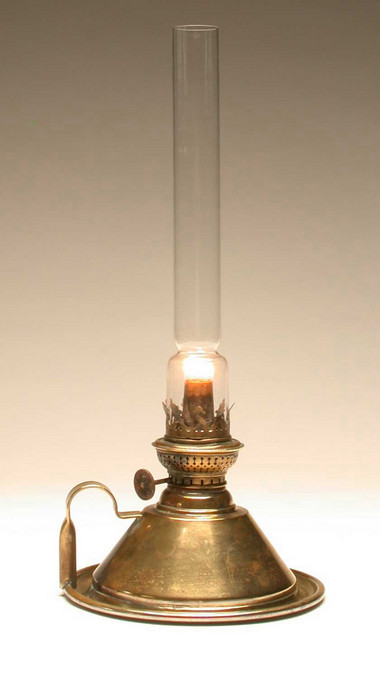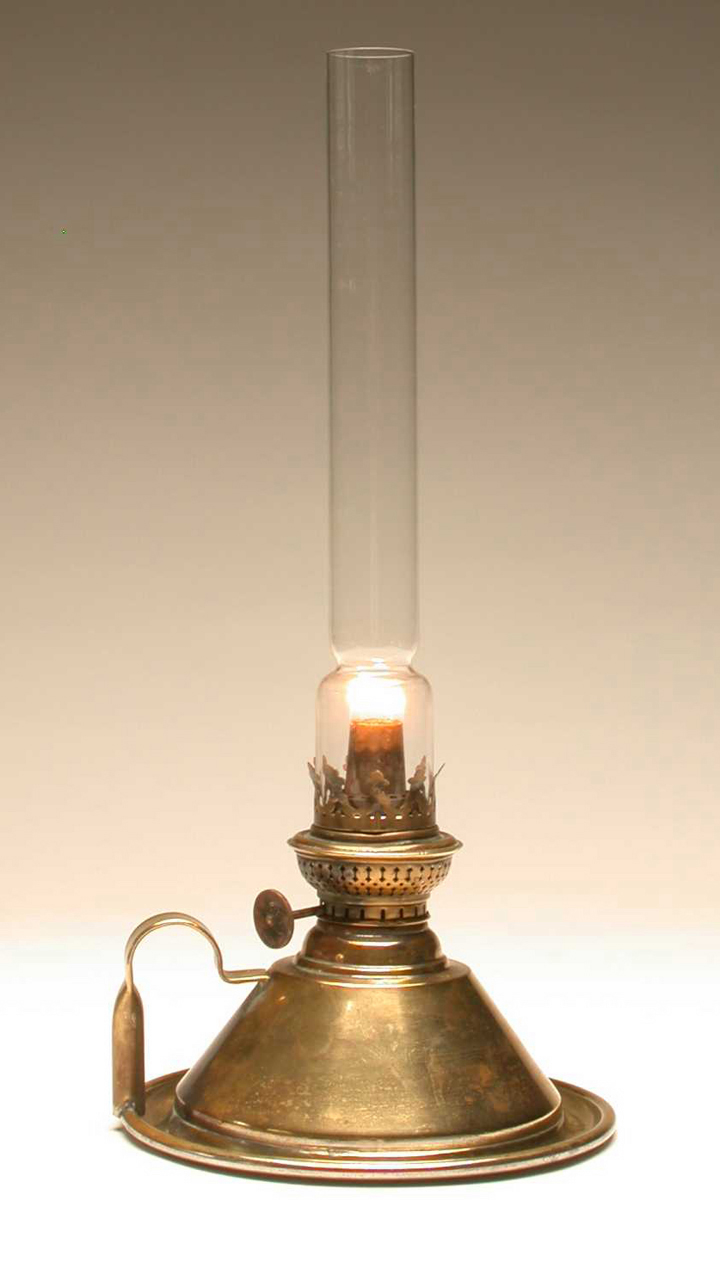Oil Lamp, Victorian, Original
This lamp from the 1860s is based on a revolutionary lamp designed in 1782 by Swiss inventor, Ami Argand.
Like many lamps made before it, this lamp is based on the simple idea of producing a light by burning a wick in oil. The special features of this lamp are the shape and fabric of the wick and the addition of the long glass chimney. These innovations increased the level of illumination tenfold without the equivalent increase in fuel expenditure.
The wick in this lamp is a long, wide flat ribbon of cotton, bent into a tube so that air is drawn up through the centre. This hollow wick improves air supply to the flame, which therefore burns brighter. Earlier wicks did not have these features.
The long glass chimney further improves the aeration to the flame by creating an upward draft. The wick soaked up paraffin oil from the base of the lamp by capillary action alone.
Once the wick was lit, it would keep burning as long as there was oil in the brass base of the lamp. The level of illumination could be moderated by winding the wick up or down using the pin on the side of the lamp. The long tube of glass would be placed on top of the wick holder once the wick was lit.
Although paraffin was cheaper than previous fuels used for lighting, it was still too expensive to burn enough lamps to light up an entire room. The solution was, therefore, to have lamps that were mobile and could be used where needed. So the base of the lamp has a handle attached to it which allowed it to be carried to where ever lighting was required - in a room or to light the way up the stairs to bed.
Like many lamps made before it, this lamp is based on the simple idea of producing a light by burning a wick in oil. The special features of this lamp are the shape and fabric of the wick and the addition of the long glass chimney. These innovations increased the level of illumination tenfold without the equivalent increase in fuel expenditure.
The wick in this lamp is a long, wide flat ribbon of cotton, bent into a tube so that air is drawn up through the centre. This hollow wick improves air supply to the flame, which therefore burns brighter. Earlier wicks did not have these features.
The long glass chimney further improves the aeration to the flame by creating an upward draft. The wick soaked up paraffin oil from the base of the lamp by capillary action alone.
Once the wick was lit, it would keep burning as long as there was oil in the brass base of the lamp. The level of illumination could be moderated by winding the wick up or down using the pin on the side of the lamp. The long tube of glass would be placed on top of the wick holder once the wick was lit.
Although paraffin was cheaper than previous fuels used for lighting, it was still too expensive to burn enough lamps to light up an entire room. The solution was, therefore, to have lamps that were mobile and could be used where needed. So the base of the lamp has a handle attached to it which allowed it to be carried to where ever lighting was required - in a room or to light the way up the stairs to bed.

Height:35cm Base Diameter:16.6cm
Oil has been used as a fuel for lighting and cooking since ancient times. Earliest oil lamps were fibres burnt in oil of some kind placed in a shell or a crevice in a rock. Communities used whatever type of oil was available locally - from plants, animals or fish. Animal fat or tallow was usually used to make candles and plant and fish oil could be used in lamps. (See the 'Romans' section in Homes for an example of oil lamp powered by olive oil.)
Oil lamps and candles coexisted as forms of lighting for centuries. Both suffered from similar problems of creating unpleasant smells, smoke and having a flame that was difficult to control.
Ami Argand, a Swiss inventor, produced a lamp in 1782-4 that revolutionised lighting. The special feature of his lamp was the wider, flat wick that he bent around to form a tube. This hollow wick was superior to earlier versions as it drew air up toward the flame and therefore made combustion more efficient. The flame would burn brighter. Plus, the glass chimney created an upward draft, which further aerated the flame.
In early versions of the lamp, colza, carcel or rapeseed oil was used. This oil is too heavy to be drawn up the wick by capillary action alone. Therefore the carcel lamp had a clockwork pump to force the oil up the wick. The Moderator lamp, patented in 1836, used a spring mechanism to achieve the same effect. The only mechanism in the paraffin lamp is the rack and pinion - a metal tube carrying the wick that can be raised up and down by the metal pin on the side.
Discovered in the oil fields of Pennsylvania in 1860s, paraffin oil was then introduced into Britain. It heralded another minor revolution in lamp design for a number of reasons:
Oil lamps were eventually replaced by gas lighting. Gas lighting was first demonstrated in 1792 and gas lamps and fittings widely used by the end of the 19th century. Gas was itself eventually replaced by electricity, the form of power that we rely on today for most of our lighting.
Oil lamps continue to be used for decorative purposes in homes today.
Oil lamps and candles coexisted as forms of lighting for centuries. Both suffered from similar problems of creating unpleasant smells, smoke and having a flame that was difficult to control.
Ami Argand, a Swiss inventor, produced a lamp in 1782-4 that revolutionised lighting. The special feature of his lamp was the wider, flat wick that he bent around to form a tube. This hollow wick was superior to earlier versions as it drew air up toward the flame and therefore made combustion more efficient. The flame would burn brighter. Plus, the glass chimney created an upward draft, which further aerated the flame.
In early versions of the lamp, colza, carcel or rapeseed oil was used. This oil is too heavy to be drawn up the wick by capillary action alone. Therefore the carcel lamp had a clockwork pump to force the oil up the wick. The Moderator lamp, patented in 1836, used a spring mechanism to achieve the same effect. The only mechanism in the paraffin lamp is the rack and pinion - a metal tube carrying the wick that can be raised up and down by the metal pin on the side.
Discovered in the oil fields of Pennsylvania in 1860s, paraffin oil was then introduced into Britain. It heralded another minor revolution in lamp design for a number of reasons:
It was much lighter than previous oils and could move up the wick by capillary action alone. Therefore, the later lamps like the one shown here did not need a mechanism to force the oil up the wick.However, poorer families still had to rely on candles for the majority of their lighting needs.
It was cleaner, more stable and odourless.
It was more affordable.
Oil lamps were eventually replaced by gas lighting. Gas lighting was first demonstrated in 1792 and gas lamps and fittings widely used by the end of the 19th century. Gas was itself eventually replaced by electricity, the form of power that we rely on today for most of our lighting.
Oil lamps continue to be used for decorative purposes in homes today.

Height:35cm Base Diameter:16.6cm

This lamp from the 1860s is based on a revolutionary lamp designed in 1782 by Swiss inventor, Ami Argand.
Like many lamps made before it, this lamp is based on the simple idea of producing a light by burning a wick in oil. The special features of this lamp are the shape and fabric of the wick and the addition of the long glass chimney. These innovations increased the level of illumination tenfold without the equivalent increase in fuel expenditure.
The wick in this lamp is a long, wide flat ribbon of cotton, bent into a tube so that air is drawn up through the centre. This hollow wick improves air supply to the flame, which therefore burns brighter. Earlier wicks did not have these features.
The long glass chimney further improves the aeration to the flame by creating an upward draft. The wick soaked up paraffin oil from the base of the lamp by capillary action alone.
Once the wick was lit, it would keep burning as long as there was oil in the brass base of the lamp. The level of illumination could be moderated by winding the wick up or down using the pin on the side of the lamp. The long tube of glass would be placed on top of the wick holder once the wick was lit.
Although paraffin was cheaper than previous fuels used for lighting, it was still too expensive to burn enough lamps to light up an entire room. The solution was, therefore, to have lamps that were mobile and could be used where needed. So the base of the lamp has a handle attached to it which allowed it to be carried to where ever lighting was required - in a room or to light the way up the stairs to bed.
Like many lamps made before it, this lamp is based on the simple idea of producing a light by burning a wick in oil. The special features of this lamp are the shape and fabric of the wick and the addition of the long glass chimney. These innovations increased the level of illumination tenfold without the equivalent increase in fuel expenditure.
The wick in this lamp is a long, wide flat ribbon of cotton, bent into a tube so that air is drawn up through the centre. This hollow wick improves air supply to the flame, which therefore burns brighter. Earlier wicks did not have these features.
The long glass chimney further improves the aeration to the flame by creating an upward draft. The wick soaked up paraffin oil from the base of the lamp by capillary action alone.
Once the wick was lit, it would keep burning as long as there was oil in the brass base of the lamp. The level of illumination could be moderated by winding the wick up or down using the pin on the side of the lamp. The long tube of glass would be placed on top of the wick holder once the wick was lit.
Although paraffin was cheaper than previous fuels used for lighting, it was still too expensive to burn enough lamps to light up an entire room. The solution was, therefore, to have lamps that were mobile and could be used where needed. So the base of the lamp has a handle attached to it which allowed it to be carried to where ever lighting was required - in a room or to light the way up the stairs to bed.
- Term:
- Description:
- Capillary
- Capillary attraction - the force, which draws liquid along a very narrow tube. This is how the paraffin oil is drawn upwards through the cotton wick, without the need of any additional mechanism in the lamp.
- Combustion
- The burning of substances to produce heat and light, made possible by oxygen in the air.
- Paraffin
- A liquid obtained from petrol and used as a fuel or solvent in heaters and lamps. Also known as kerosene.




















